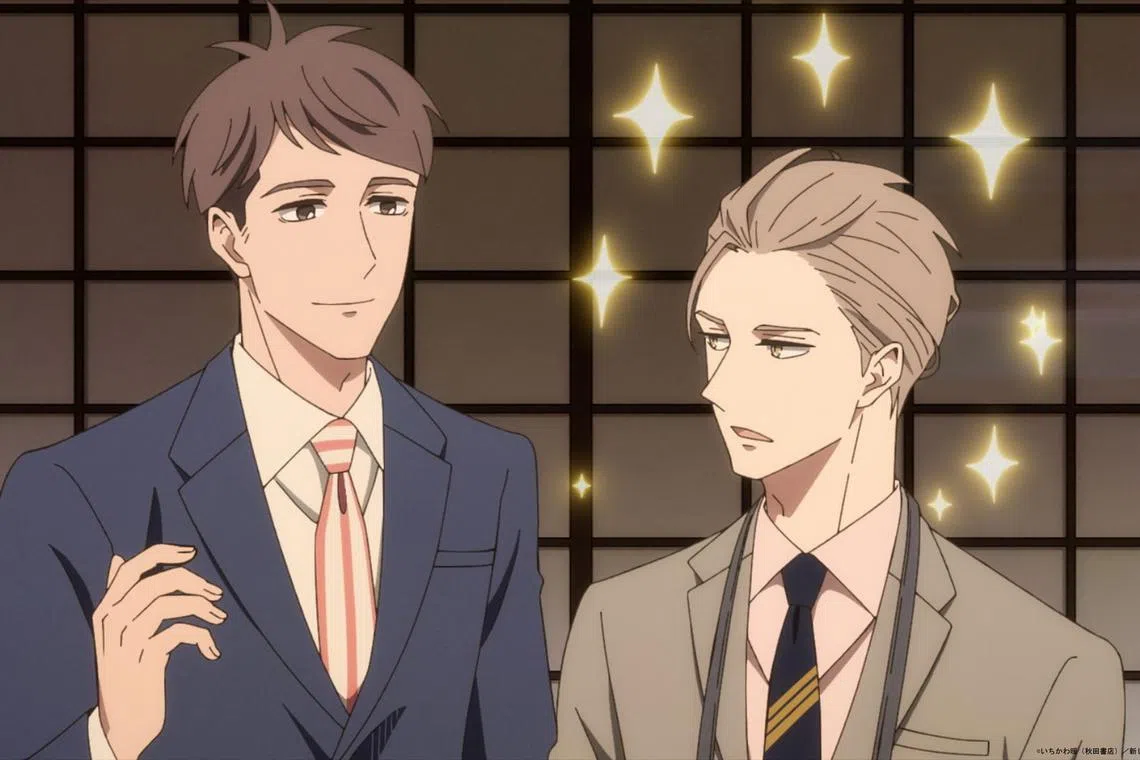Binge-worthy: My New Boss Is Goofy is a relaxing slice-of-life story
Sign up now: Get ST's newsletters delivered to your inbox

A still from the Japanese anime series My New Boss Is Goofy, about advertising agency employee Kentaro Momose (left) and his superior at work Yusei Shirosaki (right).
PHOTO: DO_TENNEN_ANIME/TWITTER
Follow topic:
My New Boss Is Goofy
Netflix
4 stars
In the sweet Japanese anime My New Boss Is Goofy, Kentaro Momose is a nervous 26-year-old advertising agency employee. He suffers workplace harassment and abuse that leaves him traumatised with longstanding stomach problems.
After finally leaving his toxic workplace, he finds a job at a new agency. He is initially anxious about meeting his superior – the seemingly cool-looking Yusei Shirosaki. But it quickly becomes apparent that Shirosaki is not only kind-hearted and nurturing, but a bit of a ditzy oddball as well.
Here are three reasons to tune into the 12-part series on Netflix.
1. Relaxing slice-of-life vignettes
As with so many slice-of-life Japanese series and anime, My New Boss Is Goofy is not heavy on plot, but strings together scenes that slowly reveal more about the characters.
In the first episode, when Momose has a stomachache on the way to visit some clients, he freaks out about upsetting Shirosaki, who buys him medication instead.
In the third episode, the two chance upon an abandoned kitten after work and the whole arc simply revolves around Shirosaki adopting the animal. The kitten is a whole character too – given a voice and internal monologues as it goes from wariness to loving Shirosaki.
In a television landscape filled with thrillers, tense dramas and melancholic romances, this series is a breath of fresh air – a low-stakes escape where kittens can understand humans and the characters are good people doing good things.
2. Goofy boss antics
The central conceit of the show is that, well, Shirosaki is goofy. While “goofy” is the official English translation, the original Japanese title means something more along the lines of “a natural airhead”, or someone prone to making silly, but ultimately harmless, mistakes.
Indeed, much of the story’s laughs come from Shirosaki’s actions and the humour often punctures the more sentimental moments, providing a good balance.
Once, on the subway train, he recounts how touched he is by Momose’s story of being inspired by an advertisement he came up with. Perhaps overcome with emotion, Shirosaki ends off by dramatically walking out of the carriage, only to scoot back in after he realises he had alighted at the wrong stop.
Shirosaki’s often cool appearance also provides a contrast to his funnier moments, like when he mishears something or admits to an embarrassing childhood story with a straight face.
3. Story of healing and hope
My New Boss Is Goofy avoids diving deep into Momose’s former employment, instead choosing to – in bits and pieces – show how the trauma impacts his current work.
When he is asked to come up with an ad proposal, he immediately recalls how his previous proposals were shredded to bits in front of his face by his mean and demanding boss. Despite all his colleagues and Shirosaki being genuinely sweet and supportive of him, he cannot help but carry these burdens with him.
Even after a period of time away, he is immediately pulled back to that dark place when he receives a call from his former superior. It even triggers a painful stomachache.
Still, the series is a hopeful one and shows how, with the kindness of others, Momose slowly opens up about his past traumas and gains the courage to confront them head-on.
This is a surprisingly sensitive way for a light-hearted anime to handle such a heavy topic.


